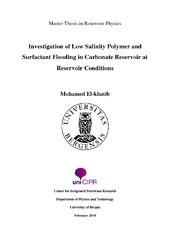| dc.description.abstract | It is estimated that 40-60% of the world’s total hydrocarbon production is from carbonate rocks [1]. Carbonate rocks contain the world`s largest fields in the Middle East (i.e., Ghawar Field, Saudi Arabia). Waterflooding is a low-cost oil recovery process and is by far the most commonly applied method for improving the oil recovery and maintain pressure support to the reservoir. The composition of water was not considered as an important factor influencing the amount of oil recovered. However, during the last decade, the low salinity water injection techniques have become one of the most important studies in the oil industry because of their possible benefits for improving oil recovery compared to conventional seawater injection. Thus, extensive studies have been developed in the composition of the injected water to an emerging Enhanced Oil Recovery (EOR) technology in carbonate and sandstone reservoirs. This increased investigations on the effect of low salinity water on oil recovery [2]. However, the mechanisms for EOR in carbonates are still poorly understood. The thesis concerns experimental studies of waterflooding performance in outcrop carbonate rock material. The wettability preference of the rock was changed by aging with crude oil at elevated temperature. The thesis compares the effects and benefits of low salinity brine injection in the tertiary mode, and when combined with a surfactant and a polymer to enhance oil recovery. Also, investigation of how aging time affects oil recovery/production in spontaneous imbibition tests. During secondary mode injection of high salinity brine, the cores resulted in recovery factors of 43-79% OOIP. In the tertiary mode, varying in production was observed, which gave an incremental oil recovery of 1-11% OOIP. It was observed that the unaged cores gave the highest oil recovery compared to aged cores. Combination of low salinity and polymer injection resulted in significant increase in oil recovery (additional 7-11% OOIP). The second low salinity injection after polymer flooding resulted in an incremental oil recovery of 2-2.4 %OOIP in aged cores. Hence low salinity seems to have a good potential in Indiana Limestone outcrop. | en_US |
